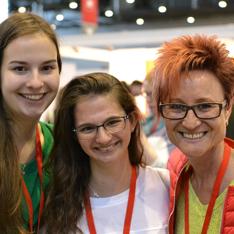North America Caribbean region webinar series
Register here to take part in the webinar
This free webinar is only open to members of World Physiotherapy member organisations in the North America Caribbean region.
Receive a 1.0 hour CPD certificate
Webinar title
Meet the authors: clinical practice guidelines on urinary conditions in women
The authors of clinical practice guidelines: rehabilitation interventions for urgency urinary incontinence, urinary urgency, and/or urinary frequency in adult women will discuss the CPG development process and the recommendations.
McAuley, J. A., Mahoney, A. T., & Austin, M. M. (2023). Clinical practice guidelines: rehabilitation interventions for urgency of urinary incontinence, urinary urgency, and/or urinary
Date and time
Thursday 18 September 2025, 23:00-00:00 UTC (19:00-20:00 EDT) Check your local time
Speakers
- J. Adrienne McAuley, member of American Physical Therapy Association
- Amanda Mahoney, member of American Physical Therapy Association
- Rebecca Reisch,member of American Physical Therapy Association
Facilitator
- Jenny Audette, North America Caribbean region executive committee chair and member of American Physical Therapy Association

J. Adrienne McAuley has 30 years of experience as a physical therapist, including 20 as faculty in doctor of physical therapy programmes. She is currently enrolled in a doctor of science programme at Andrews University and continues her clinical work in pelvic health physical therapy.
She also serves on the orthopaedic specialty panel as part of the American Board of Physical Therapy Specialties and a journal reviewer for several journals, including the Journal of Women's and Pelvic Health Physical Therapy. Adrienne was the lead author for the original clinical practice guidelines: rehabilitation interventions for urgency urinary incontinence, urinary urgency and/or urinary frequency in adult women, which is currently under revision.

Amanda Mahoney is an assistant professor of physical therapy, and faculty member of the Orthopaedic Physical Therapy Residency at LSU Health-Shreveport.
She has over 20 years of clinical experience in private practice and at LSU Health-Shreveport in the faculty practice clinic, with an interest in orthopaedics, pelvic health, and Pilates. Amanda's teaching responsibilities within the physical therapy programme include women's health and therapeutic exercise, as well as didactic material and mentoring with for the orthopaedic residency programme.

Rebecca Reisch is a clinical professor and director of research and faculty development at Graceland University. She received her master's and doctorate from Pacific University and her PhD from Rocky Mountain University.
Her professional interests include women’s and pelvic health physical therapy, evidence-based practice, orthopedic manual physical therapy, faculty mentoring, predictors of student success, and service learning. Her publications span these areas and she has presented at state, national, and international conferences.
She serves as an associate editor for the Journal of Women’s and Pelvic Health Physical Therapy and is a manuscript reviewer for several other journals.
Webinar description
The objectives of this webinar are to:
- Describe the process of clinical practice guideline (CPG) development
- Identify patients with urgency urinary incontinence, urinary urgency and/or urinary frequency
- Implement the treatment recommendations outlined in the CPG
Further reading
- Abrams P, Cardoso L, Fall M, et al. The standardization of terminology of lower urinary tract function: report from the standardization sub-committee of the International Continence Society. Urology. 2003;61(1):37–49.
- Andrade AD, Anam R, Karanam C, Downey P, Ruiz JG. An overactive bladder online self-management program with embedded avatars: a randomized controlled trial of efficacy. Urology. 2015;85(3):561–567.
- Arruda RM, Castro RA, Sousa GC, Sartori MG, Baracat EC, Girão MJ. Prospective randomized comparison of oxybutynin, functional electrostimulation, and pelvic floor training for treatment of detrusor overactivity in women. Int Urogynecol J Pelvic Floor Dysfunct. 2008;19(8):1055–1061.
- Baker J, Costa D, Guarino JM, Nygaard I. Comparison of mindfulness-based stress reduction versus yoga on urinary urge incontinence: a randomized pilot study with 6-month and 1-year follow-up visits. Female Pelvic Med Reconstr Surg. 2014;20(3):141–146.
- Baker J, Costa D, Nygaard I. Mindfulness-based stress reduction for treatment of urinary urge incontinence: a pilot study. Female Pelvic Med Reconstr Surg. 2012;18(1):46–49.
- Barroso JC, Ramos JG, Martins-Costa S, Sanches PR, Muller AF. Transvaginal electrical stimulation in the treatment of urinary incontinence. BJU Int. 2004;93(3):319–323.
- Bellette PO, Rodrigues-Palma PC, Hermann V, Riccetto C, Bigozzi M, Olivares JM. Posterior tibial nerve stimulation in the management of overactive bladder: a prospective and controlled study. Actas Urol Esp. 2009;33(1):58–63.
- Berghmans B, Seleme MR, Bernards ATM. Physiotherapy assessment for female urinary incontinence. Int Urogynecol J. 2020;31(5):917–931. https://link.springer.com/article/10.1007/s00192-020-04251-2.
- Bryant CM, Dowell CJ, Fairbrother G. Caffeine reduction education to improve urinary symptoms. Br J Nurs. 2002;11(8):560–565.
- Burgio KL, Goode PS, Locher JL, et al. Behavioral training with and without biofeedback in the treatment of urge incontinence in older women: a randomized controlled trial. JAMA. 2002;288(18):2293–2299.
- Burgio KL, Kraus SR, Borello-France D, et al. The effects of drug and behavior therapy on urgency and voiding frequency. Int Urogynecol J. 2010;21(6):711–719.
- Burgio KL, Locher JL, Goode PS, et al. Behavioral vs drug treatment for urge urinary incontinence in older women: a randomized controlled trial. JAMA. 1998;280(23):1995–2000.
- Colombo M, Zanetta G, Scalambrino S, Milani R. Oxybutynin and bladder training in the management of female urinary urge incontinence: a randomized study. Int Urogynecol J Pelvic Floor Dysfunct. 1995;6(2):63–67.
- Diokno AC, Sampselle CM, Herzog AR, et al. Prevention of urinary incontinence by behavioral modification program: a randomized, controlled trial among older women in the community. J Urol. 2004;171(3):1165–1172.
- Elgamasy AN, Lewis V, Hassouna ME, Ghoniem GM. Effect of transvaginal stimulation in the treatment of detrusor instability. Urol Nurs. 1996;16(4):127–130.
- Fjorback LO, Arendt M, Ornbøl E, Fink P, Walach H. Mindfulness-based stress reduction and mindfulness-based cognitive therapy: a systematic review of randomized controlled trials. Acta Psychiatr Scand. 2011;124(2):102–119. doi:10.1111/j.1600-0447.2011.01704.x.
- Franzén K, Johansson JE, Lauridsen I, Canelid J, Heiwall B, Nilsson K. Electrical stimulation compared with tolterodine for treatment of urge/urge incontinence amongst women—a randomized controlled trial. Int Urogynecol J. 2010;21(12):1517–1524.
- Gozukara YM, Akalan G, Tok EC, Aytan H, Ertunc D. The improvement in pelvic floor symptoms with weight loss in obese women does not correlate with the changes in pelvic anatomy. Int Urogynecol J. 2014;25(9):1219–1225.
- Gungor Ugurlucan F, Onal M, Aslan E, Ayyildiz Erkan H, Kizilkaya Beji N, Yalcin O. Comparison of the effects of electrical stimulation and posterior tibial nerve stimulation in the treatment of overactive bladder syndrome. Gynecol Obstet Invest. 2013;75(1):46–52.
- Hulbæk M, Kaysen K, Kesmodel US. Group training for overactive bladder in female patients: a clinical, randomized, non-blinded study. Int J Urol Nurs. 2016;10(2):88–96.
- Kafri R, Deutscher D, Shames J, Golombp J, Melzer I. Randomized trial of a comparison of rehabilitation or drug therapy for urgency urinary incontinence: 1-year follow-up. Int Urogynecol J. 2013;24(7):1181–1189.
- Kafri R, Shames JRM, Raz M, Katz-Leurer M. Rehabilitation versus drug therapy for urge urinary incontinence: long-term outcomes. Int Urogynecol J Pelvic Floor Dysfunct. 2008;19(1):47–52.
- Kaya S, Akbayrak T, Beksaç S. Comparison of different treatment protocols in the treatment of idiopathic detrusor overactivity: a randomized controlled trial. Clin Rehabil. 2011;25(4):327–338.
- Kaya S, Akbayrak T, Gursen C, Beksac S. Short-term effect of adding pelvic floor muscle training to bladder training for female urinary incontinence: a randomized controlled trial. Int Urogynecol J. 2015;26(2):285–293.
- Ko IG, Lim MH, Choi PB, Kim KH, Jee YS. Effect of long-term exercise on voiding functions in obese elderly women. Int Neurourol J. 2013;17(3):130–138.
- Kumari S, Jain V, Mandal AK, Singh A. Behavioral therapy for urinary incontinence in India. Int J Gynecol Obstet. 2008;103(2):125–130.
- Manríquez V, Guzmán R, Naser M, et al. Transcutaneous posterior tibial nerve stimulation versus extended release oxybutynin in overactive bladder patients. A prospective randomized trial. Eur J Obstet Gynecol Reprod Biol. 2016;196:6–10.
- Ozdedeli S, Karapolat H, Akkoc Y. Comparison of intravaginal electrical stimulation and trospium hydrochloride in women with overactive bladder syndrome: a randomized controlled study. Clin Rehabil. 2010;24(4):342–351.
- Ruiz JG, Tunuguntla R, Cifuentes P, Andrade AD, Ouslander JG, Roos BA. Development and pilot testing of a self-management internet-based program for older adults with overactive bladder. Urology. 2011;78(1):48–53.
- Siegel SW, Richardson DA, Miller KL, et al. Pelvic floor electrical stimulation for the treatment of urge and mixed urinary incontinence in women. Urology. 1997;50(6):934–940.
- Tutolo M, Ammirati E, Heesakkers J, et al. Efficacy and safety of sacral and percutaneous tibial neuromodulation in non-neurogenic lower urinary tract dysfunction and chronic pelvic pain: a systematic review of the literature. Eur Urol. 2018;73(3):406–418.
- Wang AC, Chih S-Y, Chen M-C. Comparison of electric stimulation and oxybutynin chloride in management of overactive bladder with special reference to urinary urgency: a randomized placebo-controlled trial. Urology. 2006;68(5):999–1004.
- Wang AC, Wang YY, Chen MC. Single-blind, randomized trial of pelvic floor muscle training, biofeedback-assisted pelvic floor muscle training, and electrical stimulation in the management of overactive bladder. Urology. 2004;63(1):61–66.
- Wing RR, Creasman JM, West DS, et al. Improving urinary incontinence in overweight and obese women through modest weight loss. Obstet Gynecol. 2010;116(2, pt 1):284–292.
- Yasar L, Savan K, Sönmez S, et al. Intravaginal functional electrical stimulation in the treatment of overactive bladder: results of 3 years follow-up. Gineco.ro. 2009;5(17):192–195.

